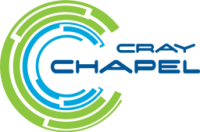Chapel (programming language)
 | |
| Paradigm | Object-oriented Partitioned global address space Parallel programming |
|---|---|
| Designed by | David Callahan, Hans Zima, Brad Chamberlain, John Plevyak |
| Developer | Hewlett Packard Enterprise (previously Cray Inc.) |
| First appeared | 2009 |
| Stable release | 2.0.0
/ March 21, 2024 |
| Typing discipline | static inferred |
| Platform | multiplatform, including Amazon Web Services, HPE Cray EX |
| OS | Mac OS, Linux, POSIX, Windows (with Cygwin), NetBSD |
| License | Apache License 2.0 |
| Filename extensions | .chpl |
| Website | chapel-lang |
| Influenced by | |
| Ada, C#,[1] C, Fortran, C++, Java, HPF, ZPL, Cray MTA / XMT extensions to C and Fortran.[2] | |
Chapel, the Cascade High Productivity Language, is a parallel programming language that was developed by Cray,[3] and later by Hewlett Packard Enterprise which acquired Cray. It was being developed as part of the Cray Cascade project, a participant in DARPA's High Productivity Computing Systems (HPCS) program, which had the goal of increasing supercomputer productivity by 2010. It is being developed as an open source project, under version 2 of the Apache license.[4]
The Chapel compiler is written in C and C++ (C++14). The backend (i.e. the optimizer) is LLVM, written in C++. Python 3.7 or newer is required for some optional components such Chapel’s test system and c2chapel, a tool to generate C bindings for Chapel. By default Chapel compiles to binary executables, but it can also compile to C code, and then LLVM is not used. Chapel code can be compiled to libraries to be callable from C, or Fortran or e.g. Python also supported. Chapel supports GPU programming through code generation for NVIDIA and AMD graphics processing units.[5]
Goals
[edit]Chapel aims to improve the programmability of parallel computers in general and the Cascade system in particular, by providing a higher level of expression than current programming languages do and by improving the separation between algorithmic expression and data structure implementation details.
The language designers aspire for Chapel to bridge the gap between current high-performance computing (HPC) programming practitioners, who they describe as Fortran, C or C++ users writing procedural code using technologies like OpenMP and MPI on one side, and newly graduating computer programmers who tend to prefer Java, Python or Matlab with only some of them having experience with C++ or C. Chapel should offer the productivity advances offered by the latter suite of languages while not alienating the users of the first.[2]
Features
[edit]Chapel supports a multithreaded parallel programming model at a high level by supporting abstractions for data parallelism, task parallelism, and nested parallelism. It enables optimizations for the locality of data and computation in the program via abstractions for data distribution and data-driven placement of subcomputations. It allows for code reuse and generality through object-oriented concepts and generic programming features. For instance, Chapel allows for the declaration of locales.[6]
While Chapel borrows concepts from many preceding languages, its parallel concepts are most closely based on ideas from High Performance Fortran (HPF), ZPL, and the Cray MTA's extensions to Fortran and C.
See also
[edit]Notes
[edit]- ^ "Chapel spec (Acknowledgments)" (PDF). Cray Inc. 2015-10-01. Retrieved 2016-01-14.
- ^ a b Chamberlain, Bradford L. "A Brief Overview of Chapel" (PDF). Cray Inc. Retrieved 22 April 2015.
- ^ Lightfoot, David E. (2006). Modular programming languages: 7th Joint Modular Languages Conference. Springer. p. 20. ISBN 978-3-540-40927-4.
- ^ "Chapel license information". chapel-lang.org. Retrieved November 15, 2015.
- ^ "Chapel Technote: GPU Programming". Hewlett Packard Enterprise. 2023-09-28. Retrieved 2023-11-03.
- ^ Bongen Gu; Wikuan Yu; Yoonsik Kwak (June 28–30, 2011). "Communication and Computation Overlap through Task Synchronization in Multi-locale Chapel Environment". In James J. Park, Laurence T. Yang and Changhoon Lee (ed.). Future Information Technology, Part I: 6th International Conference. Loutraki, Greece: Springer-Verlag. pp. 285–292. doi:10.1007/978-3-642-22333-4_37. ISBN 978-3-642-22332-7.
References
[edit]- Chamberlain, Bradford L. (2011). "Chapel (Cray Inc. HPCS Language)". In Padua, David (ed.). Encyclopedia of Parallel Computing, Volume 4. Springer. ISBN 9780387097657.
Further reading
[edit]- Brueckner, Rich (August 6, 2014). "Why Chapel for Parallel Programming?". InsideHPC. Retrieved 2015-03-23.
- Dun, Nan; Taura, K. (2012). "An Empirical Performance Study of Chapel Programming Language". 2012 IEEE 26th International Parallel and Distributed Processing Symposium Workshops & PhD Forum. IEEE. pp. 497–506. doi:10.1109/IPDPSW.2012.64. ISBN 978-1-4673-0974-5. S2CID 5904611.
- Padua, David, ed. (2011). Encyclopedia of Parallel Computing. Vol. 4. Springer Science & Business Media. pp. 249–256. ISBN 9780387097657.
- Panagiotopoulou, K.; Loidl, H. W. (2016). "Transparently Resilient Task Parallelism for Chapel" Parallel and Distributed Processing Symposium Workshops (IPDPSW), 2016 IEEE International Symposium, Chicago, IL. doi:10.1109/IPDPSW.2016.102 ISBN 978-1-5090-3682-0
